Rational Numbers to Decimal Numbers Worksheet present here will assist students in understanding the concept better. This Worksheet on Rational Number as Decimal Numbers provides ample practice questions to ace up your grip on the concept.
Converting Rational Numbers to Decimals Worksheet will aid you in practicing different kinds of questions on rational numbers to decimals conversion. We will not just provide different questions on the topic but also come up with answers so that you don’t have any difficulty in learning the concept step by step.
Also, Check:
- Problems on Rational Numbers as Decimal Numbers
- Problems Based on Recurring Decimals as Rational Numbers
Rational Numbers as Decimals Worksheet
Example 1.
Express \(\frac { 5 }{ 42 } \) as a decimal fraction and correct up to 3 places?
Solution:
Given Rational Number is \(\frac { 5 }{ 42 } \)
To obtain the decimal fraction of the given rational number we need to simply divide the numerator with the denominator. The Long Division Process is such
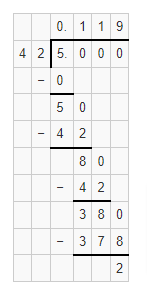
Therefore, \(\frac { 5 }{ 42 } \) converted to decimal fraction up to 3 places is 0.119
Example 2.
Without actual division, find which of the following fractions are terminating decimals?
(i)\(\frac { 7 }{ 15 } \)
(ii)\(\frac { 130 }{ 256 } \)
(iii)\(\frac { 58 }{ 200 } \)
Solution:
(i)\(\frac { 7 }{ 15 } \)
We Can say if a number is terminating or non-terminating by using the formula below
If the Denominator can be expressed in the form n = 2^m*5^n where m, n =0,1,2…..
Here Denominator = 15
We can’t express 15 in the form of 2^m*5^n so it is a non-terminating decimal.
(ii)\(\frac { 130 }{ 256 } \)
If the Denominator can be expressed in the form n = 2^m*5^n where m, n =0,1,2….. then it is terminating decimal or else a non-terminating decimal
Here Denominator = 256
We can express 256 in the form of 2^m*5^n i.e. 2^7*5^0
Thus, the given fraction is a terminating decimal.
(iii)\(\frac { 58 }{ 200 } \)
If the Denominator can be expressed in the form n = 2^m*5^n where m, n =0,1,2….. then it is terminating decimal or else a non-terminating decimal
Here Denominator = 200
We can express 200 in the form of 2^m*5^n i.e. 2^3*5^5
Thus, the given fraction is a terminating decimal.
Example 3.
If \(\frac {4 }{ 13 } \) is changed into a decimal number then what type of decimal number it is?
Solution:
Given Rational Number is \(\frac {4 }{ 13 } \)
To obtain the decimal fraction of the given rational number we need to simply divide the numerator with the denominator. The Long Division Process is such
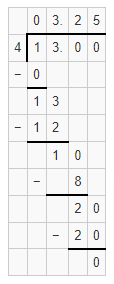
\(\frac {4 }{ 13 } \) is a non-terminating decimal.
Example 4.
Write the following fractions as decimal numbers?
(i)\(\frac {1 }{ 3 } \)
(ii)\(\frac {13 }{ 9 } \)
(iii)\(\frac {17 }{ 54 } \)
Solution:
(i)\(\frac {1 }{ 3 } \)

\(\frac {1 }{ 3 } \) converted to a decimal fraction is 0.333…..
(ii) \(\frac {13 }{ 9 } \)
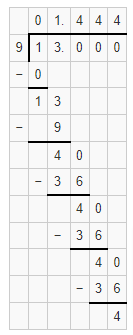
\(\frac {13 }{ 9 } \) converted to decimal fraction is 1.444…..
(iii) \(\frac {17 }{ 54 } \)
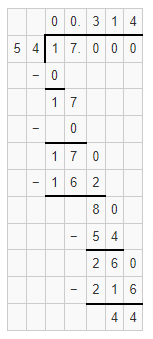
\(\frac {17}{ 54 } \) converted to decimal fraction is 0.314
Example 5.
Express \(\frac {8 }{ 23 } \) to decimal form and correct up to 4 places?
Solution:
Here Divisor = 23, Dividend = 8.
Performing Long Division Process we can get the decimal form as follows
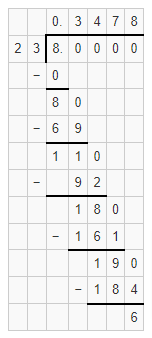
\(\frac {8 }{ 23 } \) converted to decimal form is 0.3478
